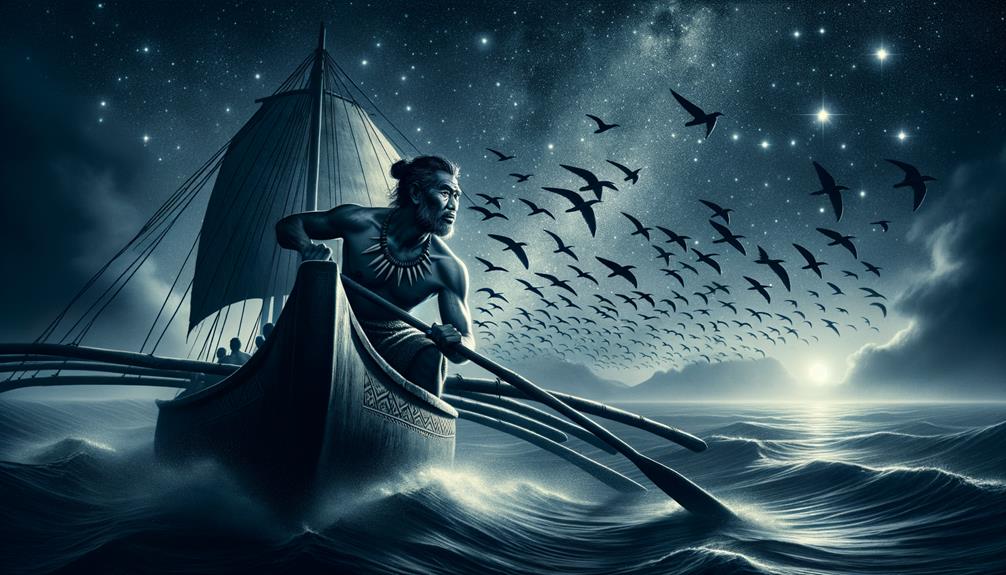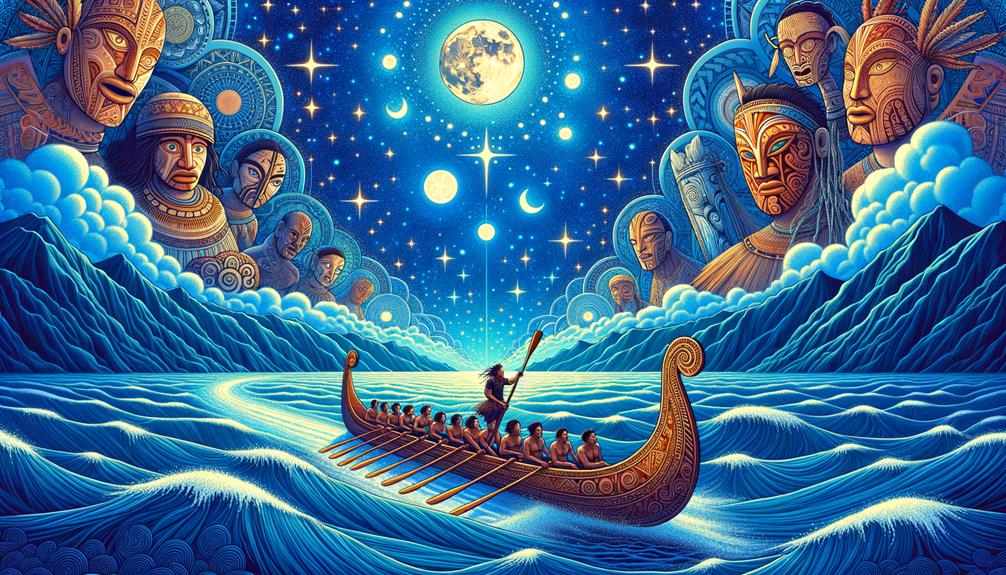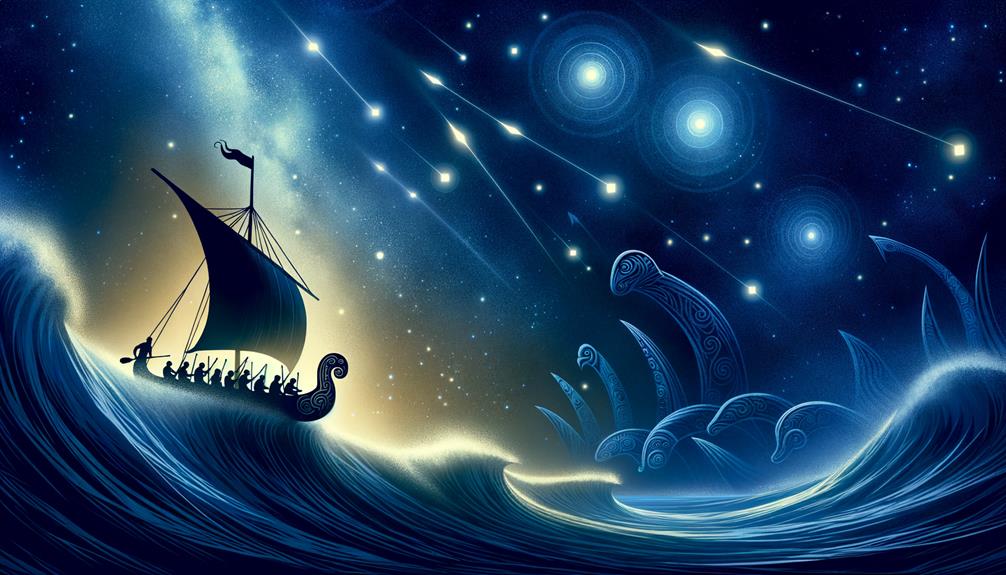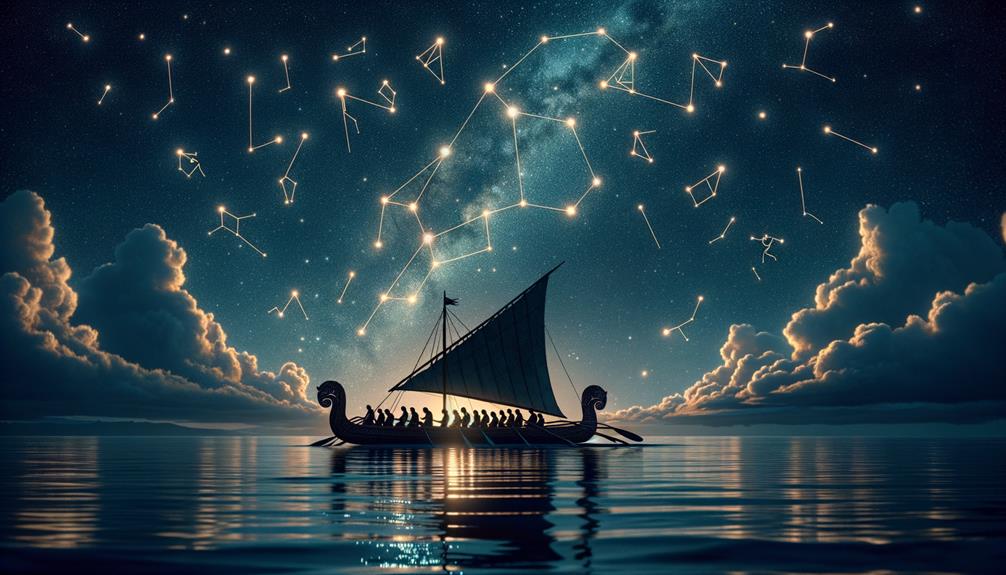Kupe's legendary adventures on the high seas tell the tale of how he found New Zealand. He employed celestial maps, observed bird flights, noticed changes in water hues, and made sense of wave echoes to steer his course. This epic odyssey has deeply influenced Māori mythology. Intriguing narratives enriched with cultural customs tell tales of Ngake, Matiu, Makaro, Turi, and Rongorongo. From a contemporary perspective, Kupe's extraordinary journey symbolizes the founding of New Zealand. Although the exact date of his landing remains a topic of ongoing debate, I find the complexity and variety of Kupe's heritage fascinating. We've only just begun to scratch the surface, his saga has so much more to offer.
Kupes Voyage: A Historical Perspective
When we pull back the curtain on Kupe's journey, it's like stepping into a captivating tale filled with influences from a rich cultural heritage. His voyage to New Zealand was much more than just a journey; it was a path paved with interesting interactions, like those with the mythic Ngake, and discoveries such as the precious greenstone, pounamu.
Whether it was naming islands like Matiu and Makaro, or unearthing the treasured pounamu, every step of Kupe's exploration felt like a riveting chapter from an adventurous novel. But his contributions didn't end with exploration; he also played a crucial part in helping people like Turi and Rongorongo establish themselves in this new territory, transforming this voyage into a story of human migration.
We also can't overlook the rich cultural traditions woven into this story. For instance, before Kupe went back to Hawaiki, he and Ngake performed rituals which put the land under tapu, or sacred restriction. This practice involved the stone of urutapu and represented a profound reverence for the land and its people. Then there were the feasts, a celebration of new possession, which added another layer of depth to Kupe's narrative.
Unraveling Kupes Navigational Techniques

Let's take a closer look at how Kupe, an expert in ancient navigation, managed to traverse the vast Pacific Ocean. His journey was guided by an intricate mix of star mapping, understanding of ocean streams, wind patterns, and discernment of nature's signs. Here's a breakdown of his techniques:
- Star Mapping and Ocean Streams: Kupe utilized the positions of stars and the sun to guide his path – this is known as star mapping. Concurrently, he became an expert in reading ocean streams, which served as unseen paths through the waters.
- Wind Patterns and Nature's Signs: The direction of the wind was key in determining his speed and path. Beyond that, he observed the migration of sea birds, the behavior of marine life, and shifts in water color. These observations provided essential information about his environment.
- Wave Echoes, Swell Shapes and Land Shadows: Lastly, Kupe was adept at interpreting wave echoes and swell shapes, indicators of nearby land. Land shadows also served as a crucial navigation tool during his travels.
Through these in-depth insights, Kupe managed to journey across the Pacific, leaving a trail of legendary sea exploration stories. His methods offer a vibrant glimpse into the ancient Polynesian navigation techniques.
Cultural Significance of Kupes Journey

Kupe's journey across the Pacific is more than just a tale of adventure. It's a cornerstone of Māori mythology and oral history that still resonates with various tribes, or iwi, throughout New Zealand. Each tribe has its own unique stories about Kupe's life and accomplishments, showing the deep cultural importance of his journey. The sacrifices he made and the landmarks he named continue to hold significance in different areas of the country today.
In regions like Northland and Tainui, local traditions about Kupe are still told, showing just how much his journey impacted these communities. His interactions with the land and its people set the foundation for a shared history that still influences local traditions. Each region has its own specific stories that emphasize different parts of Kupe's journey, showing the many ways his legacy is remembered and honored.
Stories of Kupe's bravery in the face of the unknown, as well as landmarks named after him, serve as reminders of a past that still echoes in the present. The cultural importance of Kupe's journey isn't just about tales of his adventures. It's a vital part of the Māori identity that's still very much alive today.
Modern Depictions of Kupes Expedition

Kupe's voyage, even today, holds a special place in our hearts and minds. The current interpretations of his expedition, whether they're in historical books, sculptures, or even video games, bring something fresh and exciting to the timeline of New Zealand's settlement. They've made Māori mythology more accessible and prominent.
- The Māori traditions of whaikōrero and waiata, which are the art of speech-making and singing, are often tied to Kupe's journey. These expressive art forms are used to craft a captivating narrative that brings Kupe's expedition to life.
- Kupe's name is associated with numerous natural features and landmarks across New Zealand. These tangible reminders of his voyage are deeply ingrained in Māori mythology and serve as living proof of his expedition.
- Acclaimed authors and researchers have painstakingly preserved Kupe's legacy. Their work offers a thorough and analytical account of his journey, adding to our knowledge of New Zealand's early settlement history.
These contemporary interpretations of Kupe's expedition help us appreciate the depth and significance of Māori culture and its pivotal role in shaping New Zealand.
Controversies Surrounding Kupes Arrival

Let's delve into a heated topic – the time of Kupe's arrival in New Zealand. With no clear consensus, the proposed dates span from 925 CE right up to the mid-14th century. The truth is lost in a web of legends and oral histories, resulting in a thrilling but complicated tale. There's a lack of agreement among experts too. Some suggest Kupe arrived in 1180 CE, whereas others, including David Abulafia, advocate for the mid-14th century.
Despite these debates, we can all agree on one thing – Kupe's fundamental role in the Māori lineage. His heroic deeds, like the defeat of Te Wheke-a-Muturangi, are remembered in legends, underscoring his importance. Tradition tells us that the Māori's founding canoes followed in the path of Kupe's journey, setting the stage for the Polynesians to make New Zealand their home.
While the exact timing of Kupe's arrival remains a mystery due to differing interpretations, his impact continues to echo through time. Māori oral history remembers him as a trailblazing explorer who made a lasting impression on the land, despite the debates about the specifics of his arrival.
Frequently Asked Questions
What Is the Most Famous MāOri Myth?
A frequently asked question about Māori myths usually revolves around the most popular one. That's when the story of Kupe usually comes up. Kupe was a Polynesian explorer who, over a thousand years ago, found what we now know as New Zealand. His journey was packed with various exciting episodes and incidents.
What Is the MāOri Octopus Myth?
You know what's a fascinating story? The tale of Kupe, a brave adventurer, who had a face-off with Te Wheke-a-Muturangi, a humongous octopus, during his sea journey. The way Kupe managed to outwit and conquer the monstrous creature, it truly embodies the victory of courage over challenges. This theme of overcoming hardships is actually quite common in Maori legends. Cool, isn't it?
Where Did Kupe Travel?
So, you're curious about Kupe's travels? Well, let me tell you, he had quite an adventure. He set out from a place called Hawaiki and made his way to what we now refer to as New Zealand, but back then, it was known as Aotearoa. He didn't just stick to the mainland though. Nope, he covered a lot of ground, or should I say, water. Among his many stops were North Cape and Hokianga, not to mention a bunch of different islands. Oh, and along the way, he happened to come across greenstone. Quite the traveler, wasn't he?
Who Is Kupe's Daughter?
Did you know that Kupe, a prominent figure in Māori culture, had two daughters? Their names were Matiu and Makaro. These two ladies played a crucial part in their father's journey, and their legacy continues today. In fact, if you ever visit Wellington Harbour, you'll find two islands named after them. It's a beautiful way of remembering their contribution and keeping their stories alive.


